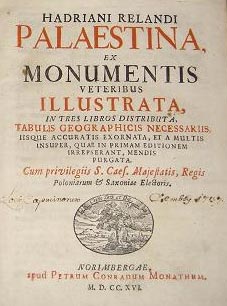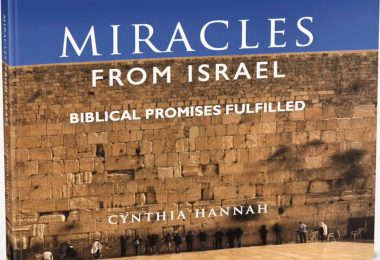

So what are some of the things we learn about Palestine circa 1696?
1. Not one place in Eretz Israel has a name that originates in Arabic.
Place names are Hebrew, Greek or Roman (Latin), that were given meaningless Arabic derivations. Akko, Haifa, Yafo, Nablus, Gaza or Jenin have no meaning in Arabic, and city names like Ramallah, Al-Khalil and Al-Quds lack historic or philological Arab roots. In 1696, the year of the survey, Ramallah was called Bt’ala (=Beit-El), Hebron was Chevron, and the Cave of the Machpela was Al-Khalil, Arabic for patriarch Avraham.2. The country was a wasteland. Its few inhabitants were concentrated in cities like Jerusalem, Acre, Safed, Jaffa, Tiberias and Gaza. Most of the city folk were Jewish or Christian, and only a few Muslims, usually Bedouins. Nablus (Shechem)was an exception, home to some 120 Muslims and 70 Shomronim (Samaritans). Natzeret (Nazareth), capital of the Galilee, was inhabited by 700 Christians. Some 5000 people lived in Jerusalem, most of them Jews. Interestingly, Muslims are mentioned only as nomadic Bedouins, who served as seasonal agriculture and construction workers. The population of Gaza was equally divided between Jews and Christians. The Jews raised grapes, olives and wheat crops (Gush Katif), while the Christians were occupied in commerce and transportation of goods. Safed and Tiberias also had Jewish communities, but the only occupation mentioned is fishing in the Sea of Galilee. A city like Um-al-Fahm, for example, is mentioned as a small village consisting of 10 Christian families, with a small Maronite church.
3. Relandi’s book completely refutes postmodern theories about a Palestinian nation or a “Palestinian tradition”, and reinforces Jewish ownership of the land, to the total exclusion of the Arabs, who even stole and adopted the Latin name of Palestine. 700 years of Arab rule in Spain, for example, have left a real cultural Moorish legacy of literature, architecture, engineering, medicine and the like. Andalusia and Guadalajara are undeniable facts, whereas in Israel, there is nothing that is Arab: no city names, no culture or art, no history, and no evidence of Arab rule. There is only a legacy of violence and robbery of the Jews’ promised, most sacred land.
Granted, some of this analysis is a little harsh. Say what you will about Palestine in 1696, but today there exists a clearly defined Palestinian national identity. OK so it’s very fractured and is often superseded by religious, political and clan-based affiliations, but one can’t deny its existence. The discovery of this book however ought to put to rest any notions of a clearly defined Palestinian historical connection to the land etc. Of course we ought to come to some peaceful agreement, but it ought not be based on historical fallacies – it ought to be based on historical realities as they exist today and now. The Palestinians exist and they’re not going anywhere. We exist and we’re not going anywhere either. Chuck self-righteousness out the door and deal with reality. I’ll be waiting – ready when you are!
The original article appears here in Hebrew for those of you who read Hebrew. As to the rest of you, the article could be about honey based recipes for the new year as far as you would know (Thanks MSN! Please ignore the recipe for Honey-Soy Glazed Pork Chops) …
- Hawk Tuah Girl Haliey Welch is Not Jewish. Probably. - 8/9/2024
- Jews Blessed by their High Priests - 10/14/2022
- Foolproof Mufletta Recipe & Muflettapalooza / Mimouna Invite! - 3/26/2021






CK – wise words. None of us are going anywhere and we should be basing our going forward on facts.
Which also means – I think – that we should recognize the bits and pieces of Arab traditions and cultures that *do* exist in Eretz Israel rather than denying their existence.
It is especially foolish to keep saying that Jerusalem means nothing to Muslims because it isn’t mentioned in the Q’uran.
For heaven’s sake, they starting building on the Temple Mount around 700 CE – they’ve defended the Dome of the Rock and Al Aqsa mosque again and again, and this shrine and this mosque were valued by the Ottomans.
In an open, honest discussion, Jewish claims and history will always be huge in comparison to those of the Arabs and we should be able to expose their petulant exaggerations in a friendly way.
I think a combination of friendly recognition and standing very, very firm would have worked much better than “trying to keep peace” by letting the Jordanian waqf control access to the Temple Mount and the structures built on and in it by Christians and Muslims.
But those “Christians” were Arabs?
NO! Palestinians have never existed and I don’t care that some wanderingArabs call themselves that. You’re an idiot Ck, for being so accepting of propaganda that is destroying Israel. Dumbass!
That’s pretty crazy. Dovetails with Twain’s accounts almost 200 years later.
That document is **too** good to be true. Obviously a Zionist forgery!
“The Travelogue of the Learned Cartographer of Budapest”
I’m not surprised a visitor to Ottoman Palestine in 1696 didn’t find much evidence of the people we today call Palestinians. They were known as the Qaysi-Yamani back then, and they lived in what’s now Syria. In the early 19th century, the Ottomans booted them out to get at their farmland, and only then did they begin to migrate south.
If you want to go even farther back in time, there were many reports written on the Crusades; sources are of Jewish, Christian, Muslim and plain secular origin.
Palestinians likely origin from “seamen” (many accounts claim they were pirates), that settled in those parts after the Crusades (the Muslim rulers in that area during the Crusades alternatingly were Egyptian or Seljuqs) and used to have a language of their own, which was gradually substituted by Arabic through the adoption of Islam.
Both Hebrew as well as Arabic stem from Proto-Aramaic (not too long ago, HUJI linguists deciphered some text in proto-Aramaic found in an Egyptian mausoleum; maybe they’ve got some info on that online).
Recommendations for basic reading:
Riley-Smith, Jonathan [ed.]: The Oxford Illustrated History of the Crusades
Crystal, David: The Cambridge Encyclopedia of Language